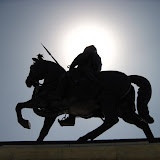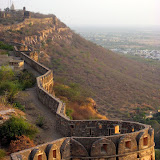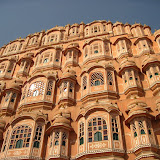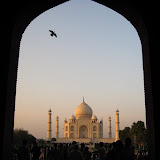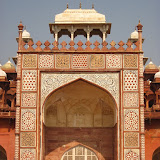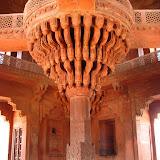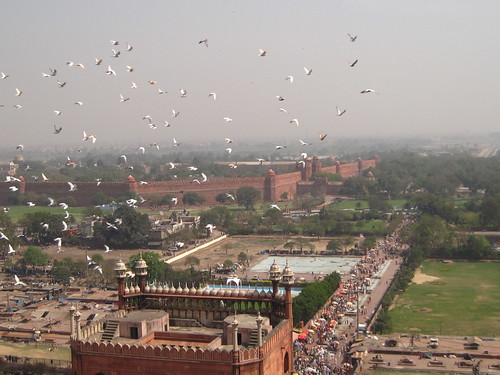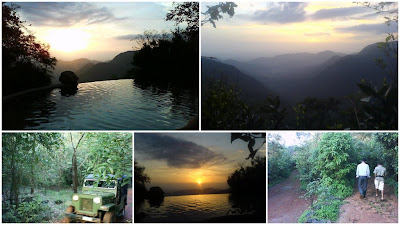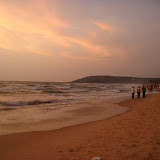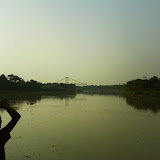The foothills of the Himalayas are known as the Duars in the Jalpaiguri district of West Bengal. In the adjacent Darjiling district, they are known as the Terai, I think. It is here in the Darjiling district that the Neora Valley National Park lies. I am writing about a tour by Durba and myself to the Duars and Neora Valley in February 2009. I am writing from memory, but even as I write, I feel the memories coming alive. It’s never too late to share a travel story, is it? And so, I present below a diary of that very special tour.
February 14
Not a soul was in sight. The sun was setting. We stood in front of a small suspension bridge across a dry stream in the middle of a forest. The Tavera which had ferried us from Sevoke, across the Teesta, past Mal Bazar, Chalsa, Matelli Bazar and Samsing, past the tea plantations stretched all the way to the horizon, had dropped us here a few minutes back and left uphill, the sound of its engine having faded completely by now. We were slowly getting used to the all-pervading silence, and beginning to enjoy it. Signage at the entrance of the bridge read: ‘Welcome, Samsing Range, Suntalaykhola Wilderness Camp, WBFDC Ltd.’. A month back, Durba and I had gone together to the office of the West Bengal Forest Development Corporation Ltd. (WBFDC) at Kolkata to book accommodation in its ‘Wilderness Camps’ in the Duars. The promise of wilderness had been met. But, let alone tourists, was there anyone here to even check us in?

The apprehension was not misplaced. The agitation for a separate Gorkhaland state was gaining momentum. There had been sudden strike calls and almost everyone save the WBFDC staff had advised us to avoid the region. But I was determined. Having fallen in love with the Duars through my past couple of visits, this was the place I wanted to take Durba to. A short walk down a cemented pathway across the bridge brought us to a group of cottages laid out on a landscaped slope. On one side stood what looked like the dining hall, combined with the office. Ganesh, the manager, was present inside. Seeing him, we heaved a sigh of relief. After all, he had spoken reassuringly about the law and order situation in these parts when we had called him from Kolkata earlier, promising us that we were totally safe inside any of the WBFDC properties. And so began our tour of the Duars and Neora Valley, our first together.
February 15
We woke up early to a misty, dew-drenched morning, the view of the forested slopes all around inviting us out of our cottage for a walk. There was a gentle purring sound outside the door. As I opened it, the camp’s cat walked right in, homing in on our bed and the warmth of our quilts! It took some cajoling to get her to agree to leave us alone! We went down to the dining hall for breakfast. The staff had already won our hearts the night before. One of the boys, Roshan, had helped us swap the ceiling mounted CFL in our cottage with the low wattage incandescent from the neighbouring cottage. The soft warm glow of the bulb had set the mood for the evening as we sat in our cottage sipping gin and biting into the tasty, piping hot pakoras served up by the kitchen. Indeed, we had the entire place to ourselves, almost, as only one more couple were checked in.
Shortly after breakfast, we met Nabin Pradhan, a lanky Gorkha in his forties probably. Nabin had come asking if we needed a ride for a sight-seeing tour. He ended up staying with us for the entire tour from here onwards. After telling Nabin to come and pick us up in the afternoon, we went for a walk down the bed of the stream flowing just outside the camp. The hours passed by and before we knew it, it was time for lunch. Nabin came with this huge Mahindra jeep after lunch and we were on our way to Mouchuki, a forest camp on the outskirts of the Neora Valley National Park. As the Range Office at Samsing was closed for some reason, we were unable to collect our pass. But Nabin assured us that the forest staff knew him well enough to allow him on in case we were intercepted without a pass.
The climb up the jeep track was steep. We stopped in the middle to watch from a distance the funeral of a dead leopard arranged by the forest staff. Then up we went, a sheer climb with a near 180 degree turn finally bringing into view the Mouchuki Forest Bungalow. Painted green and with quaint dormers, it was such an interesting building in the middle of the forest. We stood there for some time watching the mist laden hills in the distance. Then it was time to go down. We took in a view of the hydro-electric power plant at Sakkham and then drove down to another camp with tented accommodation named Rocky Island. I had come to Rocky Island on my last trip to the Duars in the August of 2007. It had been drizzling all through the day and the tea plantations were a sea of green. The jeep track down to Rocky Island was overflowing in places. I had walked all the way down, wading through the water. And then, come walking up again! The stream below the Rocky Island camp had been roaring, its waters frothing white. In the late winter evening of 2009, there was no roar, no froth! Gigantic boulders rose from the bed of the stream as the waters gurgled on gently. The sun had set and it was time for us to drive back through the darkness. The cosy comfort of our Suntaleykhola cottage beckoned.

February 16
We left Suntaleykhola in the morning. Nabin took us to an interesting little factory in a nearby village, run by a Gorkha gentleman from his home. He specialised in furniture and show-pieces sculpted out of driftwood. Impressed by the ware on display, we placed an order for a small table to be delivered to Kolkata later on. We then drove down to a shop close by to procure a few cartons of the locally grown strawberry. (We had allowed ourselves only a few of the freshly plucked, juicy, crunchy strawberries during the tour, all the while looking forward to enjoying the rest with friends and family back in Kolkata. Sadly most of the consignment decomposed in the heat and dust of the plains on our way home!)
Nabin then drove us around the Samsing settlement where he lived. We went to an abandoned bungalow with sprawling lawns at the edge of a cliff offering a panoramic view of the Kumai hills. Nabin said that the bungalow was often used by film units when they came shooting in these parts. From Samsing, we took a shortcut to the Kumai - Jhalong Road. We were now on our way to Jhalong, Paren and Bindu. On the way, Nabin stopped at a local weekly market. Villagers had come from far and wide to buy and sell. On Nabin’s recommendation, we tried out some pork curry at a stall. We still remember the delicious pork we had that day, washed down with some lovely Bhutanese beer.
The next stop was the WBFDC bungalow at Jaldhaka. What an amazing location for a bungalow! The Jaldhaka flowed right below it. At Jhalong, a group of schoolgirls requested us for a lift till Paren. A transport strike was on and the roads were empty. So in one big noisy group we reached Paren, a sleepy village on the edges of the Neora Valley National Park. We ordered lunch at the WBFDC Wilderness Camp at Paren which stood in the middle of a clearing partly ringed in by a wooded hill. Standing in the midst of tall trees, and with the densely forested hillside towering up into the sky in the background, the Paren WBFDC cottages form one of the most enduring images of the tour for me.
After a satisfying lunch of rice, egg curry and the pickled fish Nabin offered us, we went to the see the dam which stands across the River Bindu connecting India and Bhutan. We crossed the dam and walked into Bhutan. A bank of fog was rolling in from somewhere. The sky was gloomy. A strong breeze blew through the valley. The place seemed so mysterious and so far removed from civilization, in spite of being home to a hydro-electric project. We seemed to have entered into a trance and ended up spending a long time here. As we retraced our steps to India, a tiny little Bhutanese doggie was following us like a pet. Durba wondered if we could keep it. Well, that was going to be slightly difficult!
Nabin wanted to take us to a nearby hilltop to give us a bird’s eye view of the dam and the Bhutanese countryside. We hurried on in the gathering gloom, rattling up a ruined metal road. Alas, we were too late. The light had faded completely by the time we made it. We were met by the twinkling lights on the dam below. There was just the sound of the wind and of our own breathing. I felt like I was living every moment. We started our long descent to the plains after some time. Our destination was the WBFDC Wilderness Camp on the river Murti, quite some distance away. Somewhere after Jhalong (may be before, I can’t recollect exactly), we were held up by ongoing repairs to a bridge. That set us back by another hour almost. But it also meant that we would be driving through the Chapramari forests late in the evening, prime time for animal spotting! It turned out Nabin and Durba did catch a fleeting glimpse of an elephant. But, as usual, I missed out! Tired and exhausted, we reached the Murti address at last at 10-30 in the night. The WBFDC staff had been kind enough to save some dinner for us.
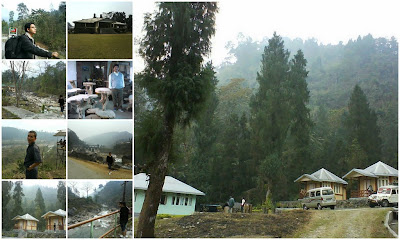
February 17
We were up before the sun today. The birds were just beginning to chirp when I slid back the window of the sitting room in our first-floor suite at the Murti camp and peered into the darkness outside. Headlamps piercing the gloom, a line of jeeps were approaching from the other side of the river over the bridge near the camp. Our dawn destination was the Gorumara National Park. Nabin drove us into the Park just after the sun had risen. We went down to Gorumara’s famous rhino watching spot. Alas, no rhinos for us! Still, no regrets. Strands of mist hanging still on the rolling grasslands stretched for acres below us, a stream quietly meandering by, the mystic beauty of the place touched our hearts. Back to the camp, we spent the rest of the morning exploring the pebbled bed of the Murti through which a mere trickle flowed, a trickle which transforms into a torrent in the monsoon months when the river is in full spate and extends bank to bank.
Lunch made us extremely sleepy. But Nabin was waiting to take us to the Chapramari Wildlife Sanctuary for the afternoon shift. Wearily rubbing our eyes we boarded the jeep. The drive through the forest rejuvenated us and we arrived at the Chapramari watchtower harbouring great expectations of spotting some wildlife. The wait was not prolonged as a herd of bisons soon descended on the watering hole, joined shortly by a stray elephant. As evening fell, Nabin took us on a safari. Suddenly we spotted a solitary bison standing right on our path and stopped. One angry look from close quarters and it trotted off into a clump of bushes. WBFDC organizes a cultural evening by villagers at the edge of the sanctuary overlooking the Murti (Or is it the Neora river? I am not able to recollect clearly). A bevy of village girls danced to Nepali songs on a raised stage as we watched from our seats under a shed. Far away, the evening train to New Jalpaiguri slowly disappeared over the horizon.
We rode back to the Murti camp in the darkness. Reaching close to our camp, I asked Nabin to stop in the middle of the forest. He did so and switched off the headlights. It was such an amazing feeling sitting quietly in total darkness watching the dance of fireflies and listening to the music of the jungle orchestrated by myriad insects and other creatures. Were we being watched by unseen eyes from the woods? There could be so many possibilities! I recorded the sound of the forest on my phone. Nabin brought us out of our trance, switching on the headlights and turning the engine back on. It was after all not very safe being parked in the middle of nowhere in pitch darkness in what was elephant and bison country. Back in our suite at the camp, we settled down by the window of our sitting room. Would a herd of elephants come calling from across the river tonight? The prospect kept us awake for some time. But tired as we were, we ended our vigil soon and turned in for the night.

February 18
Today we decided to travel uphill again, all the way to Loleygaon. This was the one day on the tour that we had not planned for in advance. Nabin suggested we go to Loleygaon. Durba suggested we enjoy Murti for one more day. I said that we should try out Loleygaon, a decision we were not going to regret.
We set off after breakfast. Nabin drove through Mal Bazar and, after Gorubathan, we started climbing steadily. It was a picturesque journey and we kept stopping at places en route to take in the scenery. We had noodles and some yak cheese at a small village on one of our halts. Around noon, we reached the town of Lava. We had started in light clothing in the morning. It was windy up here in Lava and the chill in Lava made us scramble for our jackets and pullovers. After a short visit to the Lava monastery, I asked Nabin to see if he could arrange to take us to a place I had earlier read about – the Chaudapheri Camp inside the Neora Valley National Park (Lava is one of the entry points of the Park). Nabin took us to the Range Office, Upper Neora Range, from where passes are issued for visits to the Park. The formalities took some time as no one was to be found in the office initially. Finally we were on our way, the tour party augmented by a guide and a couple of Forest Department staff.
We slowly rumbled up a jeep track that was so steep and sharply twisted in some stretches that it looked almost impossible to negotiate. Here, on this path that no one seemed to tread on except the stray villager, and in the midst of towering pines, clouds seemed to have found a cosy nesting ground for themselves. Drenched in mist, we crawled upwards through this melancholy world, the chill intensifying at each bend. I don’t remember how long we drove. Time seemed to have stopped. Suddenly the mist thinned. We had emerged out of the clouds and stopped at a clearing in the middle of the forest basking gloriously in the afternoon sunshine. Standing in front of us was a log hut with signage which read: ‘Chaudapheri Camp, Upper Neora Range, Wildlife Division II, Established - 2002, Altitude - 2372 m’. Some distance away, there were steps leading up to another hut which seemed to be a recent addition. This was the Red Panda Camp inside the Neora Valley National Park, a natural habitat for red pandas which, I believe, are an endangered species.
Treks through Neora Valley National Park start from here. If trekking for more than a day, one can halt at forest villages deep inside the Park. One of the names I can remember is Rochella. In fact, trekking all the way through the Park, one can emerge at Mouchuki, which we had visited earlier. One can also emerge at Todey, near Paren. But I had read that it is not an easy trek all the way. We decided to see what it was like for the first few kilometres. And so, with the sticks that our guide had given us each, we started to climb. Slipping, swaying, tottering we went, making a spectacle of ourselves to our guide out of our total inexperience! Under a canopy of leaves so dense the sun did not shine through, walled in by an impenetrable screen of bamboo on both sides, our path was a treacherous moist carpet of leaves and twigs and moss.
At one point, our guide invited us to follow him up a tree inclined at an angle across a sheer drop, promising a majestic view of the Kanchenjunga from the other side if the weather was clear. Durba didn’t seem confident. So I told her to wait at the bottom of the tree and shout just in case she saw any ‘kala bhalu’ or black bear approaching, a possibility our guide was happy to share with us! I managed to scramble through but, alas, no Kanchenjunga! The side we had come from was shileded from view by dense foliage. Suddenly, we heard Durba screaming from somewhere close. Alarmed, I shouted to know what had happened. Continuing to scream, she informed that she was fine, but we should get back immediately. We complied and, on the way back, found her perched on the middle of the skywalk. Apparently, she had mustered enough courage to try and join us, but had slipped in the middle and almost fallen off!
We took some rest after this incident and decided to head back, making heavy weather of our ‘trek’ as were from our utter lack of preparation and application. Durba wondered what if she had really met a ‘kala bhalu’ on the bridge. I told her I didn’t know about black bears, but she had surely frightened the entire population of red pandas (sadly whatever remains of it) out of the Park and into neighbouring Sikkim with her screams! Nabin, who had found the incident amusing, drove us down to Loleygaon. Travelling through a pine forest that looked looking mysterious in the fading light and gathering mist, we reached our destination after sunset.

February 19
Today was the last day of our tour. We woke up in our cottage at the Loleygaon WBFDC address to find the Kanchenjunga hidden behind clouds. The sun was shining and it was a and beautiful morning. Only the Kanchenjunga was not to be seen! As in Suntaleykhola, we had the entire WBFDC property to ourselves. There were no guests in any of the cottages. The night before we had stood watching the beautiful star-studded night sky from the garden of our cottage as the lights of Kalimpong twinkled in the distance.
After breakfast Nabin took us to a local park famous for its tree bridges – a network of walkways suspended from the trunks of enormous trees. It was fun walking from tree to tree high above the ground. Finally it was time to say goodbye to Loleygaon. On our final journey with him on this tour, Nabin said he wanted to give us a taste of adventure. And so, we took a route that not many would probably be willing to take on the way down from Loleygaon! This was the jeep track that wound its way past Charkhole, through Borbot, through the Chel forest, past Chuikhim, finally meeting the plains at Bagrakote on the banks of the Lees river. We didn’t even know such a route existed. The scenery was breathtaking but progress was slow, the jeep track fit for mainly battle tanks! Not surprisingly, we seemed to be the only travellers on this road. Nabin drove patiently, but to say the ride was bumpy would be an understatement. However, the view amply compensated us for the discomfort.
Passing by Charkhole and some small hamlets, we reached Borbot, a bigger village with a market. But not before Nabin had lost his way at a fork in the middle of nowhere and driven up a wrong track, the result being that we had to drive almost a kilometre in reverse, there being no room to turn round. We can’t blame him. We were not carrying a map and even if we did, I doubt whether this route would be shown. To complicate matters, there wasn’t a soul for miles that we could seek directions from. Had it not been for a party of villagers out to gather firewood, we could very well have driven all the way back to Lava!
After a brief stopover during which we helped ourselves to some noodles and tea at a roadside shop, we entered the most exciting leg of the journey which passed through the dense Chel forest. A Forest Department staff who had a hitched a ride with us from Borbot informed us (through Nabin, who translated it from Nepali) that a tiger had been spotted in the area recently, probably having made its way down from the Neora Valley National Park. I wondered what it would be like to get stranded in the middle of this forest in the evening with a broken down jeep. As it is, it hardly seemed to receive human footfall apart from villagers and the forest personnel and there was no mobile connectivity.
We bid adieu to our forest guard after the Chuikhim village. Some villagers were erecting a shed for trekkers. Apparently, an eco-tourism initiative had been launched in Chuikhim and treks introduced through the forest here. Soon afterwards, we could see the Lees meandering its way through the plains below. We were on our way out of the forest and emerged at the busy town of Bagrakote from where we turned on to the National Highway. We were leaving the beautiful Duars behind. One last halt was made at the Mongpong WBFDC facility close to Sevoke.
It was after crossing the Sevoke bridge that we encountered a serious problem in the form of a traffic snarl which seemed to have clogged all routes to our destination, Bagdogra. With a flight to catch at 3-30 in the afternoon, we were tense. As the minutes ticked by, I asked Durba to call the Spicejet number, almost sure that boarding had closed and the flight would take off without us. To our utter relief we were informed that the flight to Kolkata was delayed by half an hour. In the end we made it just in time. Thanking Nabin for the great service and hospitality, we ran inside the terminal for a just-in-time check in. Half an hour later, we were flying back home, to the heat and dust and humidity, to the smog and the noise of a metropolis. The forests were etched in our memory forever. Even today, when I close my eyes at times, I am transported back to Neora Valley, and Chel forest, and all those beautiful places we had been to…

Tour Itinerary
DAY 1: NSCBI Airport, Kolkata (CCU) - Bagdogra Airport (IXB) - Sevoke - Mal Bazar - Chalsa - Matelli Bazar - Samsing - Suntaleykhola WBFDC
DAY 2: Suntaleykhola WBFDC - Mouchuki Camp (Neora Valley National Park) - Sakkham - Rocky Island - Suntaleykhola WBFDC
DAY 3 - Suntaleykhola WBFDC - Samsing - Kumai - Jhalong - Paren - Bindu - Jhalong - Khunia More - Murti WBFDC
DAY 4 - Murti WBFDC - Gorumara National Park - Chapramari Wildlife Sanctuary - Murti WBFDC
DAY 5 - Murti WBFDC - Mal Bazar - Gorubathan - Lava - Red Panda Camp (Neora Valley National Park) - Lava - Loleygaon WBFDC
DAY 6 - Loleygaon WBFDC - Loleygaon - Charkhol - Barbot - Chel Forest - Chuikhim - Bagrakote - Mong Pong WBFDC - Sevoke - Bagdogra Airport (IXB) - NSCBI Airport, Kolkata (CCU)
(Special circumstances had forced us to book a flight to and fro. The alternative is to take an overnight train between Kolkata and New Jalpaiguri/New Mal Junction.)
Tour Map (all the roads and jeep tracks we travelled on are not shown)
Google Earth Tour

